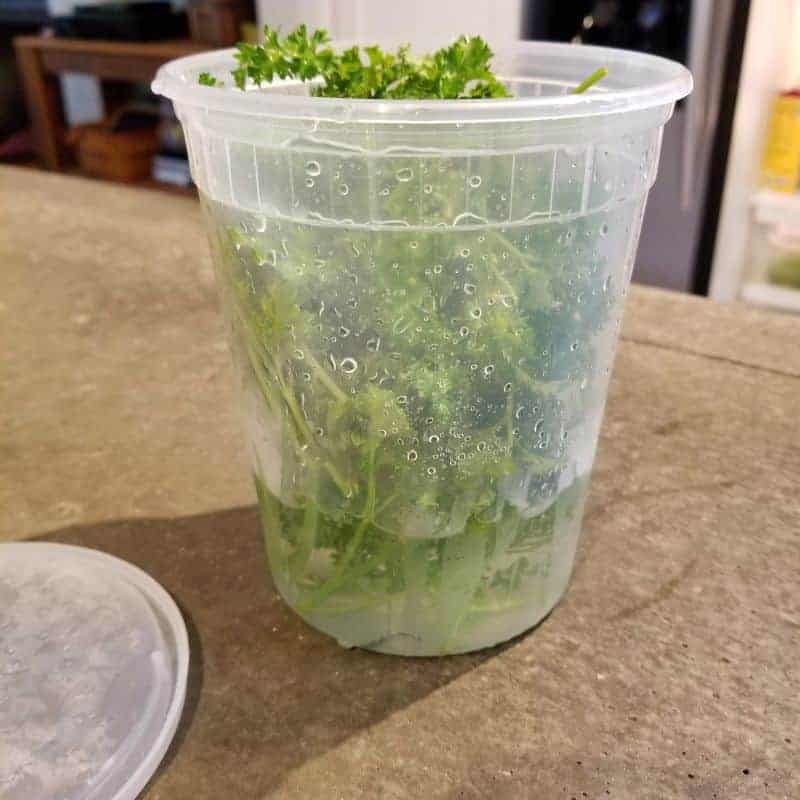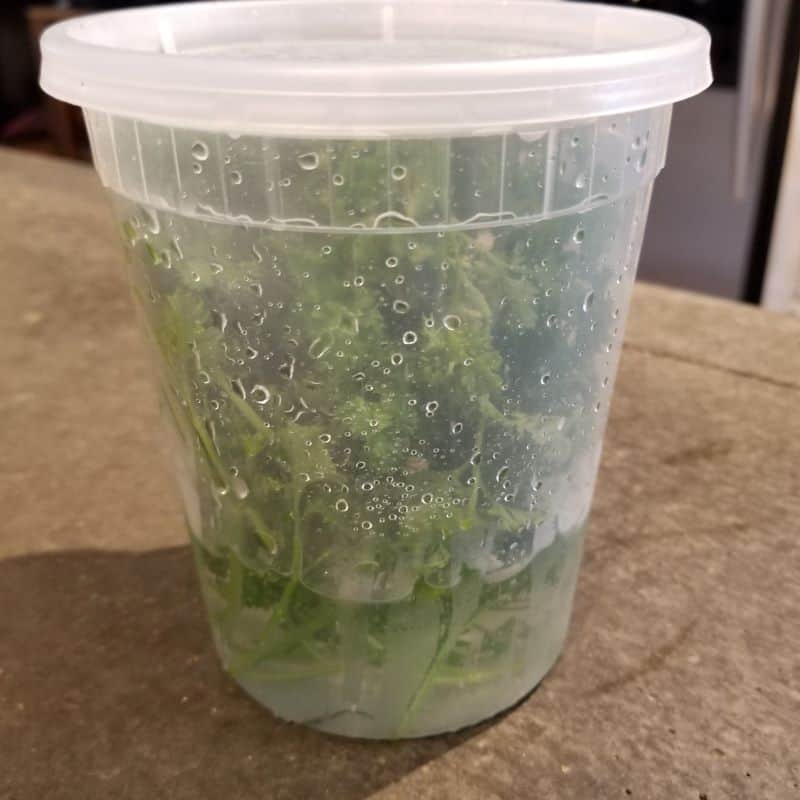How to Store Fresh Parsley for a Month or More
This site contains affiliate links to products or services that I recommend. Any purchases made through these links don’t add anything to your purchase price. It helps me keep the lights on and bring you quality travel tips. As an Amazon Associate, I earn from qualifying purchases. Thanks so much for your support!
I promised to share some tips and posts about happenings at home, so I thought I’d share this new discovery. I’ve spent a lifetime trying to figure out the best way to store fresh parsley and other delicate herbs to keep them from getting soggy so quickly and I FINALLY found something that works.

I know it’s not rocket science or brain surgery, but fresh parsley is rich in Vitamin A, Vitamin C, and Iron. I love the aroma and flavor that it adds to dishes. Besides fresh parsley that gets thrown away is a waste of money, so it seemed like a noble cause. I’m not sure why it’s taken so long for me to discover this amazing and simple method for how to keep fresh parsley longer. By the way, this also works for Cilantro.
For years I tried extending the life of my fresh parsley in normal grocery store produce plastic bags just to find it quickly turned to mush in less than a week. I also tried wrapping the parsley in a paper towel inside the bag, with minimal improvement. Then in the last few years, I tried those fancy green produce bags. You know, the ones that promise to extend the life of fruits and vegetables. I have found those to work for some produce items, like bananas but didn’t seem to help too much for parsley.

Will Parsley Stay Fresh if I Put it in Water?
The method I’ve seen recommended the most was placing the fresh parsley in an open glass jar with a little water in the bottom, and then adding a loose-fitting plastic bag over the top. This did work better than some other options. Unfortunately, I still wasn’t able to use up the parsley before it turned brown and slimy. I also risked knocking it over inside the refrigerator. Keep reading to find out what I found to be the perfect method.
The Best Method for Storing Fresh Parsley
A month or so ago I came across a suggestion that has proven to keep my fresh parsley crisp, green, and full of flavor for nearly a month and it’s still going strong! Unfortunately, I don’t know the source of the tip, because I was skeptical and didn’t save it. Now that I know it works, I thought I’d share how simple it is.

Step 1 – Buy or Grow Fresh Parsley
This sounds simple enough, but in some regions or seasons, it may be more difficult than others. Hopefully, you can pick up a beautiful bunch of crisp bright green fresh parsley from your windowsill planter, backyard garden, farmer’s market, or grocery store. Avoid bunches with yellow or wilted leaves.
You may find two different types of parsley in the market. I usually buy curly-leaf parsley, as you’ll see in the first image above and below. You may also find Italian flat-leafed parsley (in the farmer’s hand in the 2nd image above) as an option too. Which type you buy is mostly personal preference. Some say that the flat-leaf variety has a more robust flavor. I’ve always leaned toward the curly leaf probably because the flat-leafed went bad even faster than the curly. Maybe I’ll give flat-leafed a try now that I have a better method for storing it. Either bunch will normally cost around $1 to $1.50 at the store.
Step 2 – Wash the Bunch and Trim the Ends
As soon as you get to the kitchen, remove any twist ties or rubber bands from the bunch, rinse the fresh parsley under cold water to remove any dirt, and then trim a quarter inch or so off the end of all the stems.

Step 3 – Put Parsley in a Tall Plastic Container
I’m trying to avoid using plastic as much as the next person, but this same method didn’t seem to work as well with a glass jar and lid. My guess is that the glass jar seals better and doesn’t allow the necessary air circulation. A glass jar may be workable without a lid. I need to test that out.
In any case, I had an empty container from a quart of ready-made soup from the grocery store which was the perfect size. Insert the parsley as you would a bouquet of flowers in a vase with the trimmed stems at the bottom.

Step 4 – Add an Inch of Water
Once the bunch of fresh parsley is in the container add an inch or so of cold water to the bottom. You want to avoid covering leaves, if possible since they’ll get soggy underwater.
Step 5 – Add The Lid
Next, just put the lid on top of the container and place it in the refrigerator. I try to keep mine in the door of the fridge for a few reasons. It doesn’t get buried in the back and forgotten, then when I see it more often I remember to use it. It’s also less likely to get tipped over. Of course, the lid should fit tightly enough so not much water spills out, but better safe than sorry.
If the parsley is way too tall, you can try putting the lightweight plastic produce bag from the grocery store loosely on top of it, or you may be able to cut down the stems first. I personally still use the stems in everything, so I hate to waste them.

Step 6 – Trim Stems & Change Water Weekly
Repeat Step 2. Pour out the old water, trim the stems, and add fresh water at least once a week. You can do this more often if you think the parsley is starting to droop, but so far in my use, it doesn’t seem to need it more than that.
If you’re looking for the perfect herb tool for chopping parsley, cilantro, and other fresh herbs scroll down to see the hand herb scissors I found.

The image above is my parsley that’s a month old and stored with this method. It’s truly amazing how fresh it still is. The only difference between now and when I first bought it is that the stems are a little shorter because I’ve trimmed them a few times. Otherwise, you would never know it wasn’t bought fresh this week. I’m so excited about how long this is lasting and how simple it is. No fancy containers or supplies!
How Can I Keep My Cilantro Fresh Longer?
The great news is that I also use this method with cilantro. That’s a more delicate herb but still keeps much longer than usual using this water method. If you’re a cilantro lover like me, be sure to give it a try!
How to Use Fresh Parsley
If you’re not in the habit of using fresh herbs, you’ll be amazed at the difference in the flavor of your recipes compared to dry herbs. To substitute fresh herbs for dried herbs here’s a detailed article from “The Reluctant Gourmet” that includes a handy chart with the conversion rate for different kinds of herbs. In general, you’ll need 2 teaspoons of fresh parsley to equal 1 teaspoon of dried parsley. I much prefer fresh parsley because of the added crunch to recipes.
Here are just a few ideas for ways to use it: Add a few sprinkles to deviled eggs, scrambled eggs, or quiche. Top off a green salad, chicken or tuna salad or most any deli meat sandwich. Try different types of pesto to mix into your favorite pasta or create chimichurri to top grilled fish or steak. Chimichurri works well with grilled chicken, tacos, or a marinade for meat or tofu as well.
Helpful Tool for Chopping Fresh Herbs

You’ll want to get herb scissors like this that I use all the time for finely chopping herbs like fresh parsley, cilantro, mint, chives, scallions, chili peppers, thyme, dill, fennel, or basil. Of course, you can use a single knife or kitchen scissors, but these save time by cutting 5 times more at once and very thin. The cleaning comb helps you pull all the tiny bits from the scissors so nothing is wasted. The stripping tool in the set above allows you to remove leaves from the herb stems easily.
Have you seen the term “chiffonade” in one of your recipes? Chiffonade is a French cooking technique used to finely cut herbs or leafy green vegetables (including basil, parsley, sage, mint, spinach, or lettuce) into long, thin strips that resemble ribbons. In French, chiffon means “cloth” or “rag,” and chiffonade translates to “in rags.” However, most people think of it as “in ribbons” or “little ribbons,” instead. These herb scissors help you chiffonade your herbs quickly and easily so they can be used as garnishes in pasta, pizza, salads, and more.
Delicious Parsley Recipes
This Tabbouleh Salad recipe from Eating Well is another yummy way to get your vitamins and use fresh parsley, especially when tomatoes and cucumbers are in season. These cookbooks offer some excellent fresh herb recipes too.
To get more ideas, here are “15 Delicious Ways to Use a Bunch of Parsley” from The Kitchn. If you’re looking for more suggestions, do a quick search for “recipes with parsley” and see what comes up.

Parsley has often been relegated to the role of basic garnish to add color to a plate, but I think you’ll find that it’s a healthy and inexpensive treat to add to your meals. How do you use your fresh parsley? Do you grow it yourself? Let me know if you have success when you try this storage method.
Booking your trip? Here are some of the resources I use myself:
-Book great deals on flights with Cheap-o-Air
-Discover cool lodging with Booking.com
-Find the best prices and perks for cruises at CruiseDirect.com
-Reserve your vacation home rental with VRBO
-Book your car rental with RentalCars.com
-Buy your travel insurance with InsureMyTrip
-Book unique travel tours with Get Your Guide and Viator
-Find delicious culinary experiences with EatWith
-Find even more of my favorite travel resources here.
When you use these links I earn a small commission, at no extra cost to you. This helps me pay the bills and allows me to continue to create and share free tips and advice to help you travel better. As an Amazon Associate I earn from qualifying purchases.
Another amazing tip for cooking turkey
I’ve been using the same slow-cook turkey recipe for 30 years and it’s never failed me yet. Step-by-step turkey recipe here.



